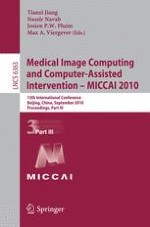The13thInternationalConferenceonMedicalImageComputingandComputer- Assisted Intervention, MICCAI 2010, was held in Beijing, China from 20-24 September,2010.ThevenuewastheChinaNationalConventionCenter(CNCC), China’slargestandnewestconferencecenterwith excellentfacilities andaprime location in the heart of the Olympic Green, adjacent to characteristic constr- tions like the Bird’s Nest (National Stadium) and the Water Cube (National Aquatics Center). MICCAI is the foremost international scienti?c event in the ?eld of medical image computing and computer-assisted interventions. The annual conference has a high scienti?c standard by virtue of the threshold for acceptance, and accordingly MICCAI has built up a track record of attracting leading scientists, engineersandcliniciansfromawiderangeoftechnicalandbiomedicaldisciplines. This year, we received 786 submissions, well in line with the previous two conferences in New York and London. Three program chairs and a program committee of 31 scientists, all with a recognized standing in the ?eld of the conference, were responsible for the selection of the papers. The review process was set up such that each paper was considered by the three program chairs, two program committee members, and a minimum of three external reviewers. The review process was double-blind, so the reviewers did not know the identity of the authors of the submission. After a careful evaluation procedure, in which all controversialand gray area papers were discussed individually, we arrived at a total of 251 accepted papers for MICCAI 2010, of which 45 were selected for podium presentation and 206 for poster presentation. The acceptance percentage (32%) was in keeping with that of previous MICCAI conferences. All 251 papers are included in the three MICCAI 2010 LNCS volumes.
